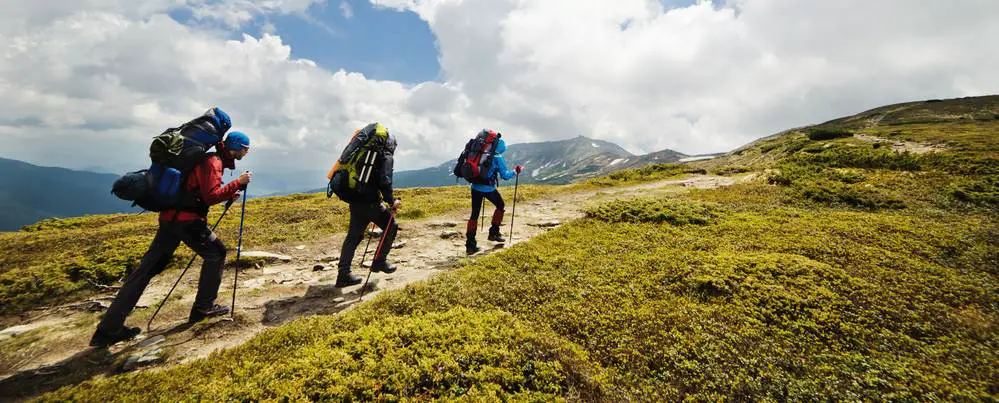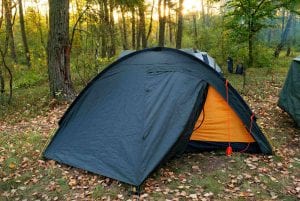
Choose the appropriate trail for your fitness level
I love long-distance A to B hikes (like the West Coast Trail on Vancouver Island). And if you’re starting out hiking yourself, it’s a real adventure to aim for! But don’t, do not, dive in at the deep end here.
Start off small and build your confidence over time. How far can you comfortably walk in everyday life right now? Find a trail that is a little bit shorter than what you think your max distance would be right now.
Or if you don’t want to think about distance, you can think instead about time. You’ll likely walk around 2mph if you are a typical, healthy, first time hiker. So if you want to walk for an hour or two, look for trails that are 2-4 miles long. That plenty long enough to get you started!
And before you know it, you’ll be hitting a 50-60 mile, multi-day trail!
Research your planned route
Always take the time to familiarize yourself with the trail you are planning to take. Get a map of the area. Dig up geographic data and reports. Does the trail loop? Or will you have to backtrack along the same route, or an alternative one?
See if there are places that make good lunch spots: lake shores, safe peaks with a view, and so on. Also, make sure to note down any trail intersections. You do not want to make a wrong turn and get lost. Check out this page for a useful tutorial on how to use a compass in conjunction with a map.
Keep track of the weather
Regularly check the weather conditions and their predictions in the days leading up to your hike. Make a point of one final check up a few hours before you physically set out.
This will be invaluable when it comes to finalizing your packing list and figuring out what exactly to wear. Moreover, keeping up with the forecast will minimize the chances of you getting a nasty surprise halfway along your trail.
Tell somebody your itinerary
This needs to be a trusted individual, like a close friend or family member, who will not be going on the hike with you. Let them know where you will be, along which route you will move, and by what time you plan to finish.
Throw in a few extra hours to account for any non-worrying delays (slow pace, stunning views, sore feet…). past that estimate, have your friend call for help and forward relevant information to authorities.
Wear the right socks and shoes
This is not an investment that you want to skimp on. Take the time to find the right model, especially since men’s and women’s hiking boots are not the same.
Wool or synthetic socks will be a better choice than cotton ones (surprising though it may sound). Also, pack up some blister remedies and band-aids, just in case.
Dress smart
You want to achieve a proper balance of functional, safe, and comfortable. The key to this is the infamous layers. In order to adjust to the weather and your own body’s temperature oscillation, make sure you can add or remove clothing as needed, at any point.
Again, avoid cotton. Sweaty cotton clothes hold onto the damp, resulting in chafing, and just overall making you all clammy and awful. Breathable synthetics are best. Finally, have a warm layer that blocks out the wind.
Have the ten essential systems
This refers to ten thematic sets of items that you need to have to stay safe outside, and especially if you have to spend the night. The ten systems are navigation, insulation, sun protection, first aid, illumination, repair supplies, nutrition, hydration, fire, and emergency shelter.
For emergency shelter, if you are not able to get your hands on a proper tent, a plastic tube tent or even a plain garbage bag will do the trick. The point is to stay dry and minimize heat loss, so feel free to adjust the ten systems’ particulars to your specific hiking needs.
Travel light
Having to carry all of this stuff around means that you have to carry it light. What this means is, do not remove anything from your cargo (you really do need it all), but pack everything in its lightest variant: a miniature sewing kit with just the basic, a travel size tube of sunscreen, etc. For some more help on the art of travelling light, check out this link: https://www.wikihow.com/Travel-Light
Pace yourself all throughout
Remember, you are on a hike, not a marathon race. You have to keep an even pace, or you will be as drained as a wringed sock by the end of the day. Pick a slower rhythm that you can comfortably maintain for a long stretch of time – your body will profusely thank you every time you have to go uphill.
Leave nothing behind
Well, footprints are fine. Trash-prints are not. Hiker code dictates that you bring at least one plastic bag to safely store all your own junk until you get home and properly dispose of it. Good etiquette also suggests that you pick up any other litter along the trail, whoever made it.





